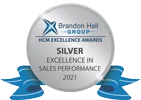The Future of Enterprise Sales

We all know there’s been a shift from salesperson-driven selling to buyer-driven purchasing. In many cases, enterprise buyers are 60 percent through the purchase process before they speak to a salesperson. The obvious implications are that buyers are better informed, so salespeople must also be. The not-so-obvious implications require a deeper dive. This article explores the future of enterprise selling and how sales leaders can strategically position themselves for the upcoming change.
Last year, we wrote about the changing dynamic of sales. The conclusion from the article can be summarized by:
“Modern selling is a framework that allows sales reps to develop authentic, compelling, and value-based solutions to their customer’s unique problems. Applying these soft skills to your selling style will result in increased productivity, improved performance, and reduced stress for both the seller and buyer. When the customer feels that you truly want to help them grow, your sales will also grow.”
That premise has not, nor will it change anytime soon. However, what if we challenge our current view of selling and take the perspective that Elon Musk might take if he were in charge of the sales department? He once said, “I think it is a mistake to hire huge numbers of people to get a complicated job done. Numbers will never compensate for talent in getting the right answer, will tend to slow down progress, and will make the task incredibly expensive.” With that in mind, let’s explore what the future of selling could look like.
Elon is famous for disrupting industries. One of the things he does well is to combine future technology capabilities with current inefficiencies. The recent takeover of Twitter is the latest example in a string of business decisions that earned him both admiration and scorn, depending on which side you’re on. Like Wayne Gretzky said, “You don’t skate to where the puck is. You skate to where it is going.” The puck is moving in enterprise sales, and it’s getting more complicated. But adding more people may not be the best solution.
If you ask enterprise stakeholders, “What is the most inefficient aspect of their purchase journey?” Information collection and analysis would be near the top. The current enterprise purchase process typically looks something like this:
- Scoping: Define requirements, timelines, and budgets
- Sourcing: Create a short list of two or three candidates
- Collection: Obtain data, demos, and custom pricing
- Evaluation: Analyze against business objectives
- Selection: Choose the best solution
The process that enterprises use to purchase and deploy technology has room for improvement, both today and in the near future. The current process is time-consuming, with numerous stakeholders having competing interests, biases, and different opinions. The more complex and expensive the purchase, the more inefficient the purchase process becomes.
The early stages of the enterprise purchase process are the most inefficient. Imagine one of Elon Musk’s SpaceX rockets taking off. The majority of energy is spent on vertical assent at the launch pad. The early stage of the enterprise purchase process is similar because the enterprise often starts from ground zero. Once the enterprise scopes the business challenges and sources and collects data, the evaluation and selection process is straightforward.
If the early stages of the enterprise purchase process are the most inefficient, those stages present a high-value opportunity for sellers to improve. The challenge is that enterprises want to source, scope, and collect their own data because they believe sellers are motivated by self-interest. They think, “Of course, you will say you are the best selection for us because you want a big commission.”
In the current enterprise purchase process, buyers view sellers merely as the payload, and the enterprise is doing all the heavy lifting early. In the future, buyers will expect sellers to carry more of that heavy lifting. What if, instead of launching by itself, the enterprise had a partner to help them clear the launch pad and reach orbit? Buyers would require the seller to deliver more personalized and transparent early-stage data. In exchange, the buyer would provide strategic insights instead of managing administrative tasks around cost and compliance.
The future of selling is facilitating a more intelligent purchase decision-making process. Instead of becoming a “one-size-fits-all” solution, sellers need to be able to analyze, customize, and personalize their solution early in the buying process. Forcing the enterprise to do all the heavy lifting early is absurd. Many buyers do not fully understand their problem’s true impact or implications, let alone how to solve it optimally.
That is one of the reasons self-service sourcing has not transpired yet in enterprise buying. It is also why artificial intelligence will not replace professional salespeople anytime soon. The complexity of enterprise solutions requires collaboration. However, sellers can anticipate the buyer’s pain points, not just in the existing business challenge but the challenge of selecting the best provider.
In stages one through three of the buying process, enterprises are accessing the seller’s validity. If the enterprise knew with 100 percent certainty who the best solution provider was, they would not go through the entire purchase process. They would skip all the stages and jump right to selection. However, given the potential negative impact of a “wrong decision,” the enterprise over-invests early in the buying process. In fact, even a “not bad decision” can hurt the enterprise in the long run if it is just a band-aid style solution.
Alternatively, salespeople waste countless hours pursuing opportunities they think they can win. However, they ultimately fail to understand the end user’s requirements and end up submitting a proposal that is rejected. For low-performing sales organizations, this is the equivalent to a “spray and pray” sales model, hoping something will stick. For high-performing teams, this means losing 50 percent of their opportunities. Both models are less than optimal.
When you look at the risks and inefficiencies of both parties, a new solution becomes clear. The buyer/seller relationship of the future will be a collaborative journey to uncover new business value. The journey will be tightly integrated earlier in the process and able to remain agile during the lifecycle. This means that both the enterprise and provider share a similar vision of the future. Said frankly, “This rocket ship is going to Mars. Don’t even think about getting on if that’s not your destination.”
The enterprise buying process may not be a trip to Mars, but the buying process is a journey to a new destination the enterprise has yet to reach. The traditional purchase process required the buyer to do all the initial heavy lifting. This slow process prevents the buyer from taking advantage of fast-changing market conditions. This creates new opportunities for sellers.
The concept of selling will change to meet these buyer challenges. Early collaboration, shared vision, and shared risk will allow buyers and sellers to unlock strategic value. It will require innovative companies to take the initiative and create new best practices. In the process, it will redefine the relationship between buyers and sellers. Early collaboration between buyer and seller will solve existing problems and create product innovation.
We’ve all experienced this at the consumer level. Remember when you were shopping in a retail store and talked to someone who knew exactly what you were looking for? You entered the store confused but left feeling energized because you found exactly what you needed. Let’s call the feeling “value-added.”
If that value-added feeling happened every time consumers went shopping at a brick-and-mortar store, Amazon would be out of business. But it is so rare, we’d rather take our chances shopping online, with the knowledge we can always return it if we are not happy. For enterprise buyers, the stakes are too high to digitalize the entire purchase process. Therefore, it’s up to the sellers to figure out how to unlock that value-added feeling. This is what we call being a trusted advisor.
Selling today looks vastly different than it did three years ago. More teams are remote and selling virtually. Selling will continue to evolve as the pace of change accelerates. For early adopters, this can lead to a competitive advantage. The details are unique for each sales organization, but winners are the sellers who make the buying process more intelligent. The main drivers for a more intelligent buying process include earlier collaboration, shared vision, and shared risks.

- Account Planning (11)
- Awards (45)
- Client Testimonial (37)
- Personal Branding (19)
- Podcast (12)
- Research (73)
- Sales Career Development (88)
- Sales Coaching (158)
- Sales Consulting (138)
- Sales Culture (172)
- Sales Enablement (365)
- Sales Leadership (111)
- Sales Management (255)
- Sales Negotiation (16)
- Sales Prospecting (135)
- Sales Role-Playing (19)
- Sales Training (235)
- Selling Strategies (270)
- Soft Skills (72)
- Talent Management (95)
- Trusted Advisor (27)
- Virtual Selling (51)
- Webinar (11)


























